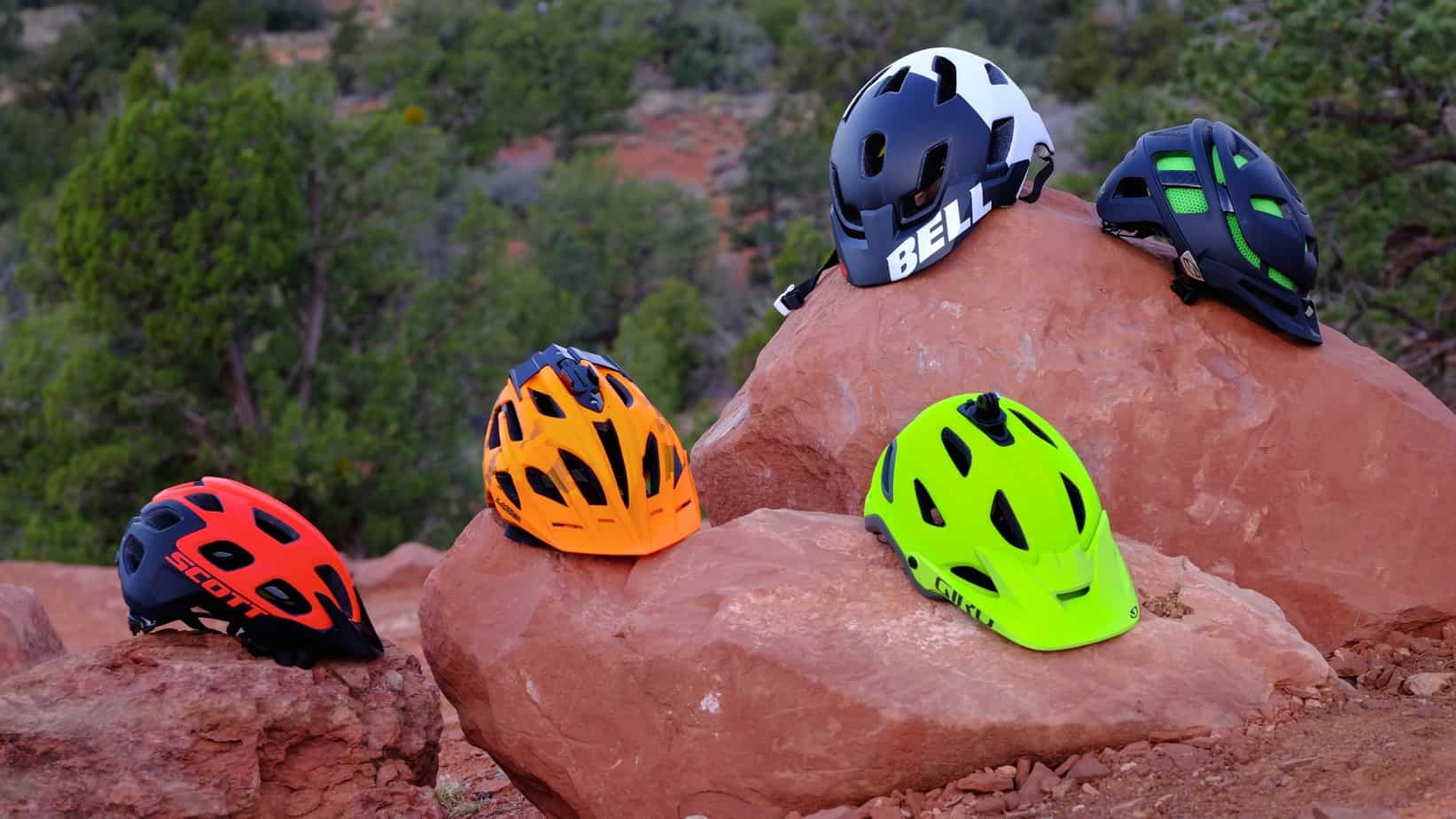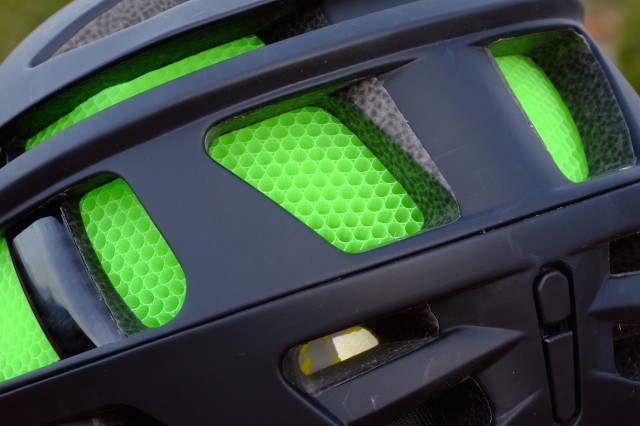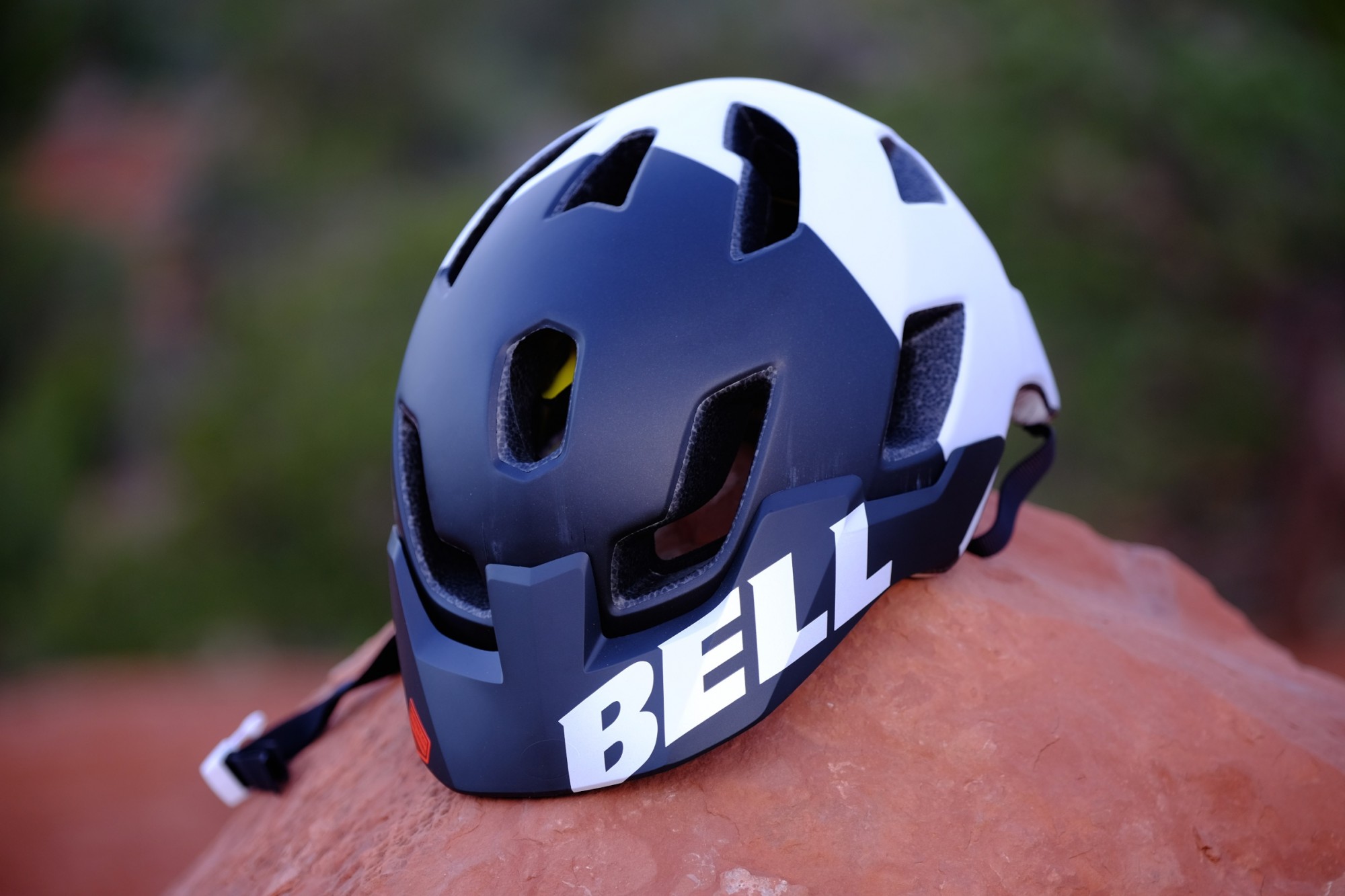Over the course of three decades of cycling I have owned countless helmets. From my first race-legal leather Cinelli, yes I’m that old, to the latest models with active brain-saving features, my head has worn them all. Today’s offerings are a marvel of engineering and are light, comfortable, and well ventilated. They also have protective properties none of us would have dreamed of just a few years ago. The most recent development comes in the form of a proprietary technology called MIPS, or Multi-directional Impact Protection System.
Founded in 2001 by five biomechanics specialists from the Royal Institute of Technology in Stockholm, MIPS is a simple yet potentially life-saving breakthrough. Their product was developed to mimic the protective layer of fluid surrounding the brain by replicating its properties within the inner layer of a helmet. Their thin plastic MIPS liner is affixed to the inside of the helmet with floating attachment points allowing the helmet to rotate slightly against the head on impact. This greatly reduces the harmful forces that cause brain injury.
Now that MIPS has become ubiquitous, more people are retiring their old lids for new models fitted with a MIPS liner. With so many choices, we thought we would take a closer look at some of the more popular offerings to see how they stack up.
https://vimeo.com/105003980
Smith Forefront MIPS, $260
You can count me amongst the many people not surprised when Smith Optics released a bike helmet. With several years of experience within the snow sports segment, their transition to wheels was a short hop. What immediately impressed me about their introductory helmet was the level of innovation injected into its development. The most interesting attribute of the Smith Forefront is the use of their proprietary Aerocore in-molded liner wrapped in a carbon fiber reinforced EPS outer shell. All of those advanced materials are made visible throughout the helmet adding to its futuristic, Tron-like appearance.
The Aerocore liner is unlike anything I have ever seen but I must admit, I was initially skeptical of its performance. Not that I doubted its ability to absorb 30-percent more impact force than EPS foam, but it looked like it could stifle air flow, and to some extent it does. The Aerocore liner has the appearance of a thousand drinking straws glued together. Despite the outer shell’s extremely large vents, air must flow through those small air channels to get inside the helmet. Although it works well to allow heat to escape, it seems no amount of wind speed can effectively force cool air into the helmet. As such, the warm weather performance of the Forefront is not stellar, but it isn’t a deal breaker either.
The other elements of the Forefront, like the two-position adjustable visor, dial-assisted retention system, and full coverage shape, cement its place within the rarified air of premium lids. The quality of materials and construction is superb, which it should be given its MSRP of $260. The fit is accommodating of a wide variety of head shapes and feels like it has deep and complete coverage of my head. The overall weight at just 331 grams for our medium sample is impressively light. All of this combines to make the Forefront one of my favorite helmets on the market.
Pros:
- Great aesthetic design
- Low weight
- Excellent fit and comfort
- Adjustable visor
Cons:
- Poor air flow in warm temps
- high purchase price
Scott Vivo Plus, $130 (Value Award)
I didn’t expect to like Scott’s new Vivo Plus as much as I did. After two months of time in it I now believe it is one of the better helmets and values in the MIPS range. With slightly less coverage than Scott’s Stego, the Vivo Plus still offers complete head protection without compromising airflow. There are 17 vents in all with 8 of them dedicated to expelling warm air from the aft end of the shell.
I am prone to nitpick and visors are regularly the subject of my derision. I loathe a flimsy visor as they seem to go missing all too often. The Vivo’s visor is attached at four steadfast points and although it isn’t adjustable, it isn’t going anywhere. The adjustment dial at the rear of the helmet is well positioned and easy to use, although it might be positioned too low for some users. The overall fit is spot on making this one of the more comfortable helmets I’ve worn in several seasons. It could just be perfectly mated to my cranium, but after soliciting other opinions, the fit does seem to work well for many head shapes.
At 346 grams it is one of the lighter helmets in the test, and it does feel light, well balanced, properly ventilated, and above all––protective. The quality of materials and construction belies the modest asking price and the MIPS liner is nicely integrated into the helmet’s interior. Lastly, the red color-way is vibrant and hard to miss in the dappled light of a shaded trail. I like other trail users to see me coming. If there is one element of the Vivo Plus that I wish were slightly better, it would be with the ventilation to the brow area. Most mountain bike helmets suffer this same weakness. Maybe it’s just me, but my forehead can get toasty.
Pros:
- Excellent ventilation
- Full coverage
- Sturdy visor
- Extremely comfortable
- Great value
Cons:
- Limited color choices
- No camera or light mounts
- Fixed visor
Lazer Oasiz MIPS, $160
The Oasiz is the top-tier mountain bike offering from Lazer with perhaps the exception of their new Revolution model designed for more aggressive riding. The Oasiz, with its XC-inspired design, has been around for a few seasons and recently received the optional upgrade with a MIPS liner.
Pulling the Oasiz from the box, it is hard not to take note of its edgy and angular form. The front is not unlike many helmets, but the back doesn’t have a single curved edge giving it a striking appearance. Aesthetics aside, there is much to love about the Oasiz, namely the refined fit and excellent ventilation. At 395 grams, this is one of the heavier helmets in the mix, but that extra weight is not noticeable. With 21 large vents, it was also a top performer when the mercury pushed north of 85ºF.
Like all of Lazer’s upper echelon helmets, the Oasiz employs the brand’s unique Rollsys fit system with the adjustment knob located at the top of the helmet. It seems like a curious place to put an adjustment dial, but it places the retention mechanism out of the way and it’s easily tuned on the fly. The crest of the helmet includes a hard mount for a GoPro or one of Lazer’s clever accessory lights, a feature we’re seeing on an increasing number of helmets. Not to belabor my issue with visors, the Oasiz has a stout sunshield mounted at multiple points on the outer shell.
As I have noticed with other Lazer helmets, the depth of the fit seems somewhat shallow, but I don’t sense I’m sacrificing coverage or stability. Those who don’t like the feel of a deep helmet will like the fit of the Oasiz. Rear protection is good without feeling clunky or compromising ventilation. The fit is snug and doesn’t bobble around when bouncing through choppy trail. One of my favorite features of the helmet is the magnetic Magic Buckle on the chin strap which eliminates the fiddling that comes with a traditional fasteners.
Pros:
- Rollsys adjustment is a nice touch
- Excellent ventilation
- Good value
- Excellent quality of materials and construction
Cons:
- Aesthetics are hit or miss for some users
- Felt slightly out of balance with the weight positioned at the back of the helmet
- A little on the heavy side
Giro Montaro MIPS, $150
New to the Giro lineup, the Montaro has understated styling and the complete head coverage commensurate with a trail-worthy helmet. With 16 large vents, it has excellent air pass-through at speed and the large ports at the crest of the shell allow for heat to escape even when not moving. For low speed climbs and hike-a-bike sessions, small details like those can provide welcome relief from sweltering heat.
Weighing in at 425 grams for our medium sample, the Montaro is on the heavy side, but it feels well balanced. The Roc Loc retention system suspends the helmet off the user’s head to help augment air flow and provides a snug, uniform fit. I was impressed by how well the MIPS liner is integrated into the inner shell, carefully sculpted as to not impede the vent performance. If I have one quibble, it is with a lack of padding at the top of the helmet where it rests against the head. It seems like a curious oversight although it doesn’t feel uncomfortable.
Available in three sizes, the range of fitment should accommodate most riders, although those with XL noggins may need to look elsewhere. As I have come to expect of helmets in this category, the Montaro comes with an adjustable visor with positive detents to secure it in one of three riding positions. I found I could substantially increase airflow to the forward aspect of the helmet by lifting the visor up two notches.
Additional features include a removable camera mount at the peak of the outer shell and a detachable goggle retention strap at the back. The vents at the rear of the helmet also have raised rubber bezels to help retain a goggle strap. Like many Giro helmets, the overall shell thickness is relatively thin so the Montaro doesn’t have as large a presence as some helmets. At $150, the Montaro is of high quality, full featured, and worthy of the ask.
Pros:
- Best visor in the bunch
- Excellent ventilation
- Excellent quality of materials and construction
Cons:
- Heavier than most in the category
- Would benefit from more pads in the liner
Bell Stoker, $95
For the last couple of years, Bell’s Super 2 helmet has been a popular choice and frequently seen at trailheads everywhere. The Stoker was released to offer similar performance, but at a much lower price point. In fact, the Stoker clocks in at more than $50 cheaper but retains many of the features of the brand’s top tier helmet.
Designed to meet the demands of the all-mountain or enduro rider, the Stoker still has excellent ventilation and comfort for all day rides. With full coverage of the temples and occipital lobe at the back of the head, the Stoker offers maximum protection. It may be more than many riders want or need, but those inclined to buy into MIPS technology are likely aware of how nasty brain injuries can be. Better safe than sorry, right?
With 13 large vents, the Stoker remained cool on even warm days of testing, but there is a compromise made with this much coverage. Surprisingly light at just 358 grams, the Stoker is well balanced and the dial-actuated retention system keeps it securely positioned with a nice uniform contact all around the circumference of the head. The mulit-position visor is a nice feature although it is a little flimsy. The ventilation to the front of the head via the four brow vents is better than expected and the padding feels sufficient and well placed.
As to be expected of a helmet at a lower price point, the in-molded foam is exposed at the inner edge of the shell requiring a little extra love and care as to not damage the helmet in transit. The only other foible might be with the thickness of the shell. If you have a big mellon, the Stoker won’t do much to make it appear any smaller. For less than a Benji, the Stoker is a great entry point into MIPS technology. It is a nice looking helmet, is available in four sizes and three subtle color choices.
Pros:
- Great value
- Maximum head coverage
- Surprisingly good ventilation
- Available in four sizes
Cons:
- Exposed foam at the edge of the shell
- The shell thickness makes for a large overall size
Conclusions
If you have been shopping for a new helmet lately, and one fitted with MIPS technology, you know that there are far more than just five options available. There are actually––dozens. The first company to break into the MIPS bike helmet category was POC and I have raved about their popular Trabec model. I’ve logged thousands of miles in that helmet, and still recommend it highly. For this particular set of five brain savers, I am hard pressed to pick a personal favorite, and even less inclined to make an outright claim that any one of them is better than the rest. Fit and personal preference will drive your final selection.
That said, I still think the Scott Vivo Plus is the best value in the bunch. The Smith is the most unique and aesthetically pleasing. For those who want a shallow fitting, well ventilated helmet, look no further than the full-featured Lazer. The Bell Stoker offers a great level of protection without breaking the bank, but not everyone will want that level of coverage. Lastly, Giro’s latest helmet is one of the nicer models they have ever produced. They are all great helmets providing superb defense against the much dreaded brain injury.



















